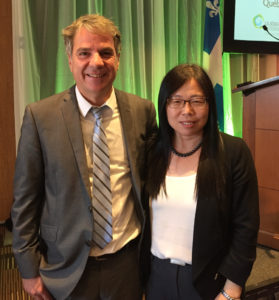Dr. Xiangguo Qiu & Dr. Gary Kobinger: Against all odds, they discovered a treatment for Ebola
This is one in a series of profiles of the winners of the 2018 Governor General’s Innovation Awards. See all honourees

Roadblocks are common here and there in research, requiring scientists to persevere and find workarounds. For Drs. Xiangguo Qiu and Gary Kobinger, the obstacles were pretty constant on the path to discovering a treatment for the deadly Ebola virus.
Working at the Public Health Agency of Canada’s National Microbiology Laboratory in Winnipeg, the two virologists focused on antibodies that had actually been tested and found ineffective in other studies. They were told repeatedly by counterparts that their research was not going to lead anywhere. Against this prevailing opinion and amidst massive budget cuts that eliminated more than a third of their program’s resources, they doggedly moved ahead. They were finally able to prove their theory and cure patients in the devastating West Africa Ebola outbreak.
“We never gave up,” says Dr. Qiu, who currently heads the Vaccine Development and Antiviral Therapies section in the Special Pathogens Program at the lab. Her primary field is immunology, with research on vaccine development, post-exposure therapeutics and rapid diagnostics of high-consequence haemorrhagic viruses, like Ebola.
“Antibody treatment until that time had failed. They didn’t believe it was going to work. We proved that it did.” – Dr. Xiangguo Qiu
“The idea is very easy. Making it work was the big thing,” adds Dr. Kobinger, who is now a professor in the Department of Microbiology and Infectious Diseases and director of the Research Centre on Infectious Diseases at Laval University in Quebec. His work focuses on developing and testing new vaccine platforms and immune treatments against emerging and re-emerging viruses of high consequence to public health.
‘My goal became to prevent death’
Their quest for an Ebola treatment began in 2005 when Dr. Qiu, a medical doctor from China who came to Canada for graduate studies in 1996, started working on the antibody treatments. Antibodies are naturally occurring molecules produced by the body as a defense mechanism against infection, like missiles in the blood that attack a foreign pathogen. Dr. Qiu identified eight antibodies that showed promise in recognizing and attacking Ebola, and by 2008 had narrowed that down to a “cocktail” of three. The key to the combined antibodies is that they slow down the rapid advance of the Ebola virus, preventing it from replicating. This “buys time” to let the body’s own immune response fight the infection.
“We could see survival in large animals; they could be cured from Ebola,” says Dr. Kobinger, who was then chief of the of the Winnipeg lab’s special pathogens program and worked in concert with Dr. Qiu.
“This was really a eureka moment. Treating Ebola at the time was science fiction, because the virus kills the host so quickly. You’re working on a very short timeline to try to stop the process,” says Dr. Kobinger, a Quebec City native and self-described “medical school dropout”, who spent a year planting trees and travelling, but went back to university after returning home sick from a trip to India. “I became fascinated with viruses … My goal became to prevent death.”
The two researchers found themselves working against a budget that was cut by 36 percent. “We had to decide which projects to continue and which to put on ice. Qiu and I agreed that this was promising and we had to keep going,” Dr. Kobinger says, noting that one source of funding for the antibody project was a Department of National Defence program that financed high-risk research linked to bioterrorism.
Scientists say Ebola cure could work on other diseases
Once it was confirmed that the three antibodies combined were effective in animal models, the treatment was developed into a drug called ZMapp. This was successfully used on compassionate, emergency grounds in humans for the first time in July 2014 to treat American medical missionaries Kent Brantly and Nancy Writebol. Infected with the Ebola virus while in Liberia, they received ZMapp and advanced supportive care and fully recovered.
“My proudest moment was when Kent and Nancy survived,” says Dr. Kobinger. The treatment was given to a total of 28 patients with the Ebola virus infection at the time and 25 of them made a complete recovery. The biggest legacy of their discovery, he says, is that it “has stimulated a response from the scientific community to say, ‘Wait, this approach really works against infectious pathogens. If it works against Ebola, it’s going to work against a lot of other viruses.”
ZMapp is now driving an explosion of similar research against other infectious agents such as HIV, Lassa fever and the Marburg virus, Dr. Qiu reports.
“So many labs are developing antibody therapies for other diseases,” she says. “I’m very happy. It’s not just that we found a cure for Ebola, but our work is having an impact on the whole scientific community. It has become a blueprint for treating those other infectious diseases.”
To be more innovative, Canada should …
… give young investigators support, because it’s when you’re early in your career that you come up with all these crazy ideas. That’s innovation. What I’d like to see is funding agencies taking risks. They should take risks in line with the risks that those young scientists take. Because it’s by chasing what we call crazy ideas that new concepts and paradigm-shifting projects happen.
—Dr. Gary Kobinger
Our proudest moment …
… was when the first Ebola patient was saved by ZMapp.
—Dr. Xiangguo Qiu
My advice to innovators is …
Being an innovator is not only to have the idea—you also have to make it happen. To make it happen is to never give up and keep finding solutions. It’s almost a day-to-day approach, where you just want to have enough ideas and resources for the next day, every day. —Dr. Gary Kobinger





